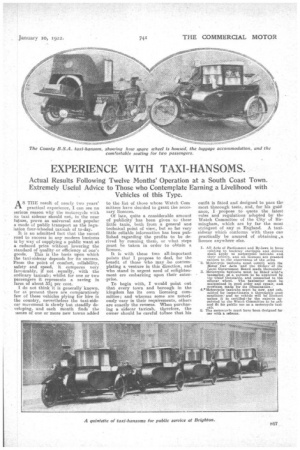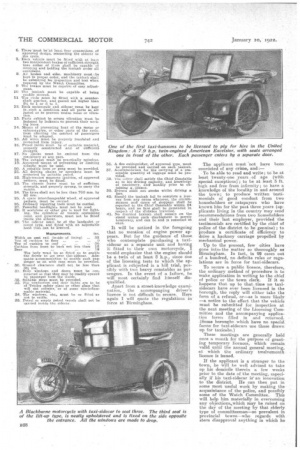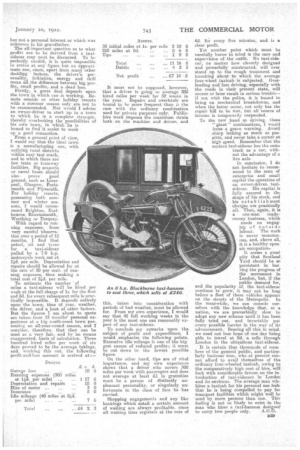EXPERIENCE WITH TAXI-HANSOMS.
Page 25

Page 26

Page 27

If you've noticed an error in this article please click here to report it so we can fix it.
Actual Results Following Twelve Months' Operation at a South Coast Town. Extremely Useful Advice to Those who Contemplate Earning a Livelihood with Vehicles of this Type.
AS THE result of nearly two years' practical experience, I can see no serious reason why the motorcycle With its taxi sidecar should not, in the near f4ukie, prove as universal and popular a mode of public transport as the regulation four-wheeled taxicab of to-day. It is an admitted fact that the surest road to success irk any modern business it by way of supplying a public want at a reduced price without lowering the standard of quality or efficiency of one's
goods. This is the basis upon which the taxi-sidecar depends for its success. From the point of comfort, ieliability, safety and speed, it compares very favourably, if not .equally, with the ordinary taxicab; whilst for one or two passengers it represents a saving in fares of about 331 per cent. I do not think it is generally known, for atpresent there are comparatively few of these vehicles plying for hire in the country, nevertheless the taxi-sidecar movement is slowly but steadily developing, and each month finds the lames of one or snore new towns added to the list of those whose Watch Corn mittees have decided to gtant the necessary licences. Of late, quite a considerable amount of publicity •has been given to these little taxis, both from a general and technical point of view, but so far very little reliable information has been pubtithed regarding the profits to be derived by running them or what steps must be taken in order to obtain a licence.
It is with these two all-important points that I propose to deal, for the benefit of those Who may .be contemplating a venture in this direction, and who stand in urgent need of enlightenment ere embarking upon their enter
To begin with, I would point out that every town and borough in the kingdom has its own licensing committee; and whereas some are notoriously.easy in their requirements, others are exactly the reverse. When purchasing a sidecar taxicab, therefore, the owner should be careful toisee that his
outfit is fitted and designed to pass the most thorough tests, and, for his guidance, I propose to quote the latest rules and regulations adopted by the
Watch Committee of the City of Birmingham, which are by far the most stringent of any in England. A taxisidecar which conforms with these can practically be assured of obtainingsa licence anywhere else.
1. All Acts of Parliament and By-laws in force relating to hackney carriages and drivers shall apply to motorcycle, taxicabs and. their drivers, and all licences are granted subject to.the observance of the same.
.2. Motorcycle taxicabs must compl3 with the Motor Car Acta and the Orders" of the Local Government Board made thereunder 3. Motorcycle taxicabs must be fitted' withma taximeter, of a pattern to he approved by the Chief Constable, and connected to the silleear wheel. rho taximeter must be maintained in good order and repair, and provision made for its Illumination...
4,,Motercycle'taxicabs must be new and submitted for luspectiontin a thoroughly good condition: and no vehicle will be licensed unless it iv certined t by thit experts ap pointed by the Watch Committee to be safe and St for public use as a motorcycle taxi
cab.
5. The motorcycle must have been designed for use with a brckaar. 6. ThereMust Wet least, four connections. of approved design, connecting the sidecar to the cycle. Each vehicle must be fitted with at least two independent brakes of sufficient strength that, either of them shall be capable of stopping and holding the taxicab under all conditions.
8. All brakes and othe. machinery .must she kept in proper order, and the taxicab shalt be submitted for inspection and test when required by the Watch Committee.
9 The brakes must be capable of easy adjustment.
10 The taxicab must be capable el being readily steered. 11 Ties cycle must be fitted with a countershaft gearbox, and geared not higher than 61/4 to 1 or .5 to 1.
12. Each motorcycle and sidecar moat, be kepi in.such a condition and all parts so ad' jested as to prevent mititie noise or vibre. tins, 13. Parts subject to severe vibration must be fastened by locknuts to prevent their working loose.
14. Means of preventing heat of the motor or exliaustrpipe, or other parts of the cycle, from affecting the comfort of passengers must be adopted. 15. All wires must be properly insulated and protected from injury.
16. Petrol tanks must be of suitable material, properly constructed and of sufficient strength.
17. No smoke mast be emitted from the machinery at any part.
18. The exhaust must be practically noiseless.
19. Approved means of preventing or limiting sideslip must be used.
20. A .suitable horn or gong must be provided. pl. All driving chains or sprockets must be protected by sensible guard.
22. High-tension magneto ignition, of approved pattern, must be fitted.
23. The chassis frame imrst be of sufficient strength, and properly sprung, to carry the weight.
24. The tyres shall not be less than 700 mm. by 80 min.
25. A snare interchangeable( wheel, of approved pattern, must he carried. 26. Ordinary repairing tools must be carried.
27. Powerful headlights must not be used.
28. If acetylene OT other gas is Peed ler lighting, the cylindets or vessels' containing same, and generators, must not be fitted inside the sidecar.
29. 'Hie sidecar most be of the landaulet or coupe type, and fitted with an sullustabie hoed that can be lowered.
Measurements.
Width an seat rail (inside of lining) ...311 Top of cushion to floor
Top of cushion to sod 36 Cushion front iront to back not less than 18 Door
The body ninet be! so fitted s.s to enable the driver to -see over the, sidecar. Adequatiseaccommociation to enable each passenger to sit with ease must he provided.
30. Ground clearance shall not be less than 31. Drop windows and doors must be constructed so that they may be readily opened by passenger from the inside. 32. Suitable steps must be provided. 55. Tile windscreen and door lights are to be of Trip/ex safety glass or ether glass that will not splieter, or of some non-infiatimable material.
34. The windows, etc:, must be so fitted as not to rattle.
35. Petrol or empty petrol vessels shall not be carried in.=.ble thc sidocar.
36. A fire extinguisher, of apPnored type, must be provided and carried oil each taxicab.
37. Accommodation for the carrying of a reasonable quantity of luggage mast be pro
3
8. The driver shall satisfy the Chief Constable as to his driving capacity, and knowledge of machinery, andi locality prier to obtaining a, licence. 39. Drivers shall not smoke whilst driving a fare, 40. Should the taxicab fail to complete a journey from any cause whatever, the circumstances and cause oi stoppage shall be Teported to the Chief Constable within 24 hours, and no faro shell be demanded in respect of the distance travelled.
41. No disabled taxicab „shall remain on the stand •unless such disablement is merely temporary, and can be and is remedied at
once.
It will be noticed in the foregoing that no mention of engine power appears. But for the guidance of those. who contemplate .purchasing a taxisidecar as a separate unit and having it fitted to their own motorcycle, I would emphasize that the engine should be a twin of at least 8 h.p., since One of the licensing tests to which the applicant is silbjected is a hill trial, possibly with two heavy constables as passengers. In the event of a failure, ho will most certainly find himself disqualified.
Apart from a street-knowledge examination, the accompanying driver's licence is not difficult to secure. Here again I will quote the regulatiOns in force at Birmingham. The applicant must "not have been convicted of any crime, and
. To be able to read and write; to be at least twenty-one years of age (with special exceptions) ; to be at least 5 ft. high and free from infirmity; to have a knowledge of the locality in and around the town; to produce written testimonials of good conduct from two householders or ratepayers who have known him for the past three years (applicants living in the country may send recommendations from two householders and their last employer, provided the testimonials are certified by the chief of police of the district to be genuine); to produce a certificate of efficiency to drive a hackney carriage propelled by mechanical power.
Up to the present, few cities have gone into2 the matter so thoroughly as Birmingham. In fact, in 99 cases out of a hundred, no definite rules or regulations are in force for taxi-sidecars.
To secure a public licence, therefore, the ordinary method of procedure is to make application in writing to the chief of polies or the town clerk. If it s6 happens that up to that. time no taxisidecars have ever been licensed in the borough, the reply will either take the form of a refusal, or-as is more likely -a notice to the effect that the vehicle must be submitted for inspection at the next meeting of the Licensing Committee and the accompanying application forms filled in and returned. (Some boroughs which have no special forms for taxi-sidecars use those drawn up for taxicabs.) These meetings are generally held once a month for the purpose of granting temporary licences, which remain valid until the annual general meeting, at which the ordinary twelvemonth licence is issued.
If the applicant is a stranger to the town, he will be well advised to take up his domicile therein a few weeks prior to the date of the meeting, especially if his taxi-sidecar is an innovation to the district. He can then put in some most useful work by making the acquaintance of the police, and possibly some of the Watch Committee. This will help him materially in overcoming any objections„which may be raised on the day of the meeting by that elderly type of committeeman-so prevalent in provincial towns.-who regards with stern disapproval anything in which he has not a personal interest or which was unknown to his grandfather.
The all-important question as to what profits are to be derived from a taxisidecar may -next be discussed. To be perfectly candid, it 'is quite impossible to arrive at any figure but an approximate one, since apart from many other deciding • factors, the driver's personality, initiative, energy and skill mean all the difference between big profits, small profits, and a dead loss. Firstly, a great deal depends -upon the town in Which one is working. Remote seaside or other holiday resorts with a summer season only are not to be recommended, Nor would I advise an owner-driver to start up in a town to which he is a complete stranger, thereby overlooking the possibilities of his own town, in which he is bound to find it easier to work up a good connection.
also prove good ground, such as Liverbourne, Bournemouth, Worthing or Torquay. With regard to s
er and winter seaFor holiday resorts, possessing both summons, I would venommend Brighton, East
Tool, Glasgow, Portsmouth and Plymouth.
run
ning expenses, from very careful 1;bservalion over a period of 12 months, I find that petrol, oil and tyres for a' taxi-sidecar pulled by a 7-9 h.p. motorcycle work out at 1W. per mile. Depreciation and iepairs should be allowed for at the rate of -50 per cent, of running expenses, thus making a total cost of 2-0. per mile.
To estimate the number of miles a taxi-sidecar will be hired per week at the full.charge of Is. for the first and 8d. for every subsequent mile is practically impossible. It depends entirely upon the town, time 61 year, weather, the driver, and .a host of other factors. But the figures I am about to quote are taken from 12 months' personal experience at a big south-coast town pos-. ceasing an all-year-round season, and I 'consider, therefore, that they can be used as a very fair, and by no means exaggerated, basis of calculation. Three hundred hired miles per week of six days proved to be the average takings, and. working this out, the following profit-and-loss account is arrived at:—
It must not be supposed, however, that a driver is going to average MO hired miles per week for 52 weeks in the year. Repairs and overhauls are bound to be more frequent, than ia I he case with the ordinary combination used for private purposes only. Publichire work imposes the maximum strain both on the machine and driver, and this, taken into consideration with periods of had weather, must be allowed for. From my own experience, I would say that 45 full working weeks in the year is the most one can reasonably expect of any taxi-sidecar.
To conclude my remarks upon the subject of profit and expenditure; I would emphasise the following points. Excessive idle mileage is one of the big gest causes of reduced 'profits; it must be cut down to the lowest possible figure.
On the other hand, tips are of vital importance, and my own experience shows that a driver who covers 500 miles per week with passengers and does not average at least £.1 in gratuities must be a person of distinctly unpleasant personality, or singularly unfortunate in tbe class of fare he has carried.
Shopping engagements and any Eke bookings which entail a certain amount of waiting are always profitable, since all waiting time registers at the rate of 4d. foi. every five minutes, and is a clear profit.
Yet another point which must be carefully borne in mind is the care and supervision of the outfit. No taxi-sidecar, no matter how cleverly designed and powerfully constructed, will ever stand up to the rough treatment and knocking about to which the average four-wheel taxicab is subjected. Overloading and fast driving, especially with the roads in their present state, will sooner or later result in serious trouble-if not with the police, it is bound to bring on mechanical breakdowns, and when the latter occur, not only has the repair bill to be met, but all source of income is temporarily suspended.
To the new hand at drivieg these " giant " combinations, would issue a grave warning. Avoid sharp locking as much as possible, and never take a corner at high speed. Remember that the modern taxi-sidecar has the same track as a car, without the advantage of a live axle.
In conclusion, I do not hesitate to recom mend to the man of enterprise and small capital the operation of an owner-driven taxisidecar. His capital is fully assured in the shape of his stock, and his establishment charges are practically nil. Then, again, it is a one-man readymoney business, which needs no engaging of outside labour, The work is never monotonous, and, above all, it is a healthy openair occupation,. It seems a great
pity that Scotland Yard should be so persistent in barring the progress a the movement in London, but, if the public demand for and the popularity of, the taxi-sidecar continue to grow, it may not be long before a fleet of these vehicles appears on the streets of the Metropolis. In the meanwhile, we can console ourselves with the knowledge that, as a nation, we are proverbially slow to adopt any new scheme until it has been fully tried out, and invariably put every possible barrier in the way of its advancement. Bearing all this in mind. we need not lose hope of one day being able to travel at 8d. a mile through London in the ubiquitous taxi-sidecar.
It is certain that thousands of mem hers ofthe general 'public, and particularly business men, who at present cannot afford to avail themselves of the ordinary four wheeled taxicab, owing to the comparatively high cost of hire, will look with considerable favour on the introduction of taxi-sidecars in London and its environs. The average man who hires a taxicab for his personal use feels that he is being compelled to pay for transport facilities which might, well be used by more persons than one. This feeling is not so likely to exist in the man who hires a taxi-hansom designee to carry two people only. AG.


































